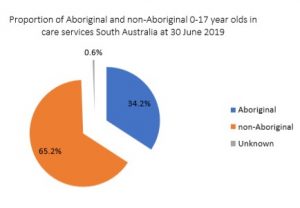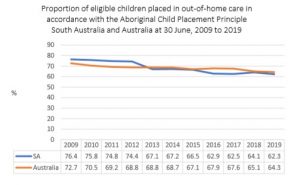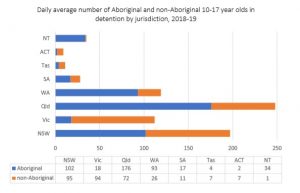The proportion of Aboriginal children and young people in care in South Australia has worsened in the last five years, with Aboriginal children and young people now making up 34.2% of all children in care.
Data from the 2020 Report on Government Services shows that this cohort continues to be drawn into the child protection system at an alarming rate. Worse still, many of these young people are likely to remain in care for extended periods of time, and only 62% are living with someone from their family, community or cultural background.
When it comes to youth detention, the over-representation is even worse. In 2018-19, Aboriginal children and young people made up a daily average of 60.7% of all young people in detention in SA, despite Aboriginal children being detained at their lowest rate since 2014-15. (While the rate of detention of Aboriginal children fell, the detention rate for non-Aboriginal children declined even further.)
Every year the Office of the Guardian for Children and Young People and Training Centre Visitor takes a ‘snapshot’ of the data from the Report on Government Services to see how it relates to South Australian Aboriginal children and young people in care and/or detention.
Four aspects of the data are particularly noteworthy.
Aboriginal children and young people are still seriously over-represented

- Despite Aboriginal children and young people making up only 5% of the state’s total population of children and young people, they make up more than a third, 34.2%, of children and young people in care services (as at 30 June 2019).
- Over four years (2014-15 and 2018-19) the rate of Aboriginal 0 to 17 year olds in care services (per 1,000 children in the SA population) increased from 49 to 76.7%. This compares with an increase from 5.6 to 7.4% for non-Aboriginal 0 to 17 year olds.
- 5% of Aboriginal children who are in care have been so for five or more years.
How do Aboriginal children’s placements reflect the Aboriginal Child Placement Principle?

- At 30 June 2019, only 62.7% of eligible children (854 of a possible 1,363) were placed in accordance with the Aboriginal Child Placement Principle.
- Over the last 10 years, there has been a decline in the proportion of Aboriginal children and young people placed in accordance with the Aboriginal Child Placement Principle, in out-of-home care in both South Australia, and nationally.
Aboriginal children and young people in residential care

- At 30 June 2019, 208 Aboriginal children and young people were living in residential care, making up 36.6% of all the children living in that care type. This was higher than the proportion of Aboriginal children living in care services overall (34.2%), meaning that Aboriginal children and young people are more likely to be placed in residential care than non-Aboriginal children.
Aboriginal children and young people in detention

- 7% of the average daily population in detention in the Adelaide Youth Training Centre were Aboriginal
- Aboriginal children and young people are 32 times more likely to be in detention than non-Aboriginal children and young people in South Australia
- South Australia spent less, on average, per child aged 10 to 17 years in the SA population, on detention-based youth justice services compared with the national average.
- The number of Aboriginal 10 to 17 year olds in detention in South Australia during 2018-19 declined to its lowest rate in four years and was lower than the Australian average for the first time since 2014-15.
You can read our full report here.
If you missed our review of SA’s government spending on child protection services, check out our previous blog post.
